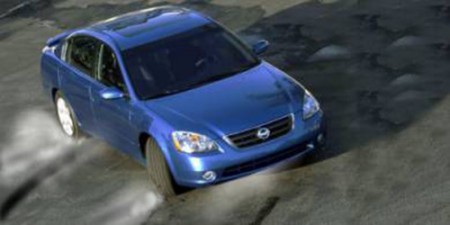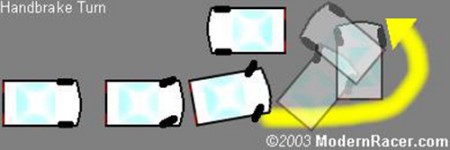Extreme Driving: Handbrake Turn

It is possible to turn the car a full 180 degrees to face the opposite direction by performing what is known as a handbrake turn. Some colorful folks even call it a bootlegger’s hairpin. In effect, it is essentially a U-turn done in the space of two lanes of road without resorting to tedious three-point turns. It is a very easy technique. However, to do it safely and accurately takes practice.
Handbrake turns are the easiest to perform with a front-wheel-drive car, although any car will do. A Kia Rio will be just as effective as a Chevy Corvette. To pull off this maneuver, drive along at about 30 to 35 mph, in first or second gear. Too slow and you won’t be able to complete a 180. Any faster and you will start going backwards after you complete the turn. The exact speed depends on road conditions and the type and condition of tires on your car.
Position one hand on the steering wheel in a way that will allow you to quickly turn it one full circle. This basically means that, on a left-hand-drive car, you place your left hand on the right side of the steering wheel, ready to flick the wheel around quickly. The exact positioning will depend on which way you want to turn. Also, with a manual car, keep one hand on the handbrake with the release button already pressed (but with an automatic, shift into neutral first, then get ready with the handbrake). Now, the key here is to start turning before you pull the handbrake. Ease off on the accelerator, floor the clutch (or in the case of an automatic, go into neutral) and quickly yank the steering wheel smoothly either left or right (or on whichever side you have more space to make a turn) until it locks. A split second after you start turning, quickly yank the handbrake lever (or, as with most American cars, apply the foot-operated e-brake), locking the rear wheels completely. At this point, you will start rotating and really feel the lateral G building up. As you are rotating, you should gradually bring your steering wheel to the center again and straighten out your front wheels. In the end, you will more or less be facing the opposite direction, at a complete stop, or moving backwards slowly. You can judiciously apply the normal foot brake (or not at all) to control the end of the rotation precisely and stop moving backwards.
If you’re feeling particularly destructive, you could go one up. While rotating, when you’ve completed about three-fourth of the 180 with the clutch pedal depressed, shift into first gear, release the handbrake (or e-brake), floor the accelerator and dump the clutch, performing all one by one quickly. You will start moving again as you complete the turn, spinning your wheels and kicking up some tire smoke if you have enough power. If you spin more than 180 degrees, you can apply some countersteer to straighten out your car while driving away. With an automatic, just move from neutral to Drive, then floor the accelerator.

Just remember – for manual cars, depress the clutch, turn, pull the handbrake (or press the foot e-brake), straighten the steering wheel, release the handbrake (or foot e-brake), shift into first, floor the accelerator, dump the clutch, and finally, countersteer to keep the car straight. For automatics, go into neutral, turn, pull handbrake (or press foot e-brake), straighten the wheel, release the handbrake (or foot e-brake), shift into Drive, floor the accelerator, and finally, countersteer to keep the car straight.
Pulling off the tire-smoking maneuver with a manual car will take a lot of practice to get it right. Try practicing in an empty parking lot or on gravel. An even better solution is an empty parking lot right after it has rained or snowed. It will be easier on your tires. Remember that pulling off 180 degree turns repeatedly will kill your tires. And be warned that this move is always risky with a tall SUV!
Posted: January 2nd, 2014
at 4:55pm by The Sub-Editor
Tagged with Handbrake turn
Categories: General News
Comments: No comments

